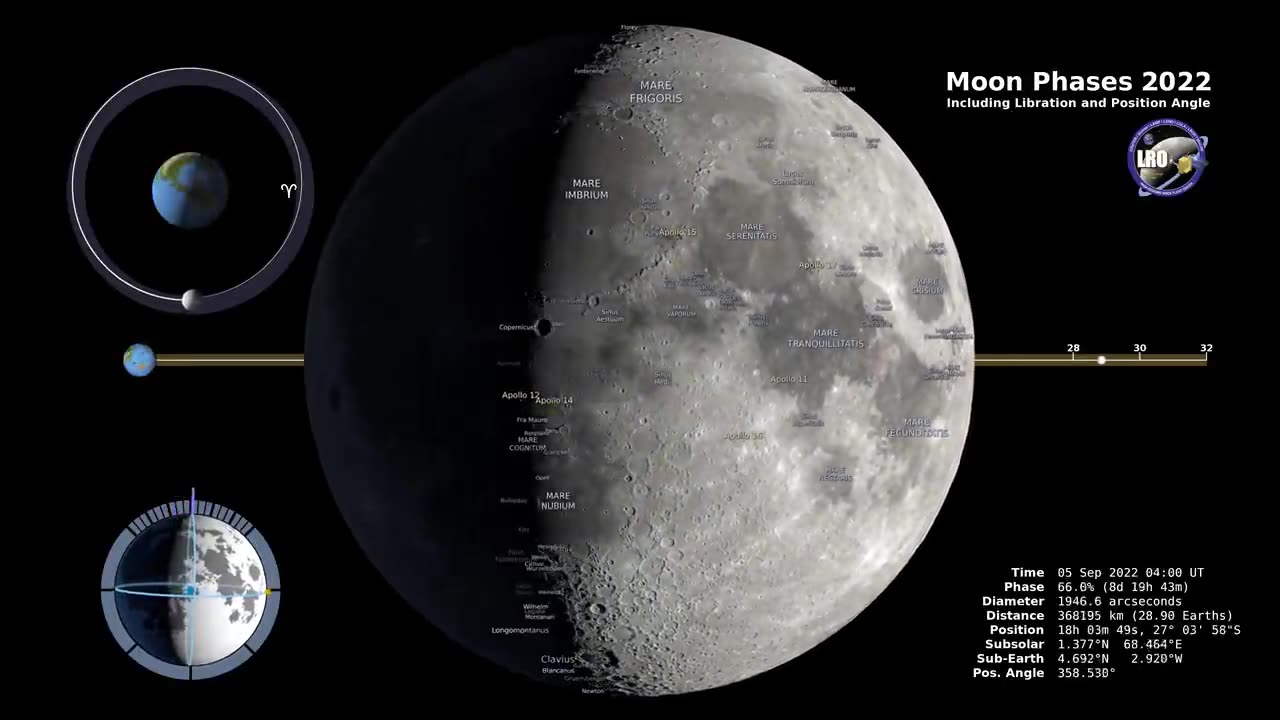Premium Only Content

Moon_Phases_2022_–_Northern_Hemisphere
Moon phases refer to the different appearances of the Moon as seen from Earth due to its changing position relative to the Sun and Earth. The Moon orbits Earth, and the amount of its illuminated half visible from our planet changes over a 29.5-day lunar cycle, creating distinct phases. These phases are as follows:
New Moon: This phase occurs when the Moon is positioned between the Earth and the Sun. The side of the Moon facing Earth is not illuminated by sunlight, making it appear mostly dark. It's difficult to observe the New Moon because it's typically very close to the Sun in the sky.
Waxing Crescent: As the Moon starts moving away from the Sun, a small portion of its right side becomes illuminated. This thin crescent is visible shortly after sunset in the western sky.
First Quarter (Waxing Half-Moon): At this point, half of the Moon's visible side is illuminated by the Sun. It appears as a half-moon shape and is visible in the evening sky, around the time of sunset.
Waxing Gibbous: As the Moon continues to move in its orbit, more than half but not yet the entire visible side is illuminated. This phase occurs after the First Quarter and before the Full Moon.
Full Moon: The entire side of the Moon facing Earth is illuminated by the Sun, making it appear as a complete circle. Full Moons are often very bright and visible throughout the night.
Waning Gibbous: After the Full Moon, the illuminated portion begins to decrease, resulting in a shape similar to the Waxing Gibbous but with the illumination now on the left side.
Last Quarter (Waning Half-Moon): Half of the Moon's visible side is illuminated once again, but this time it's the left half. This phase is visible in the morning sky, around the time of sunrise.
Waning Crescent: As the Moon continues its orbit, the illuminated portion becomes thinner and appears as a crescent shape on the left side.
After the Waning Crescent phase, the Moon returns to the New Moon phase, and the cycle repeats itself. It's important to note that the Moon's phases are caused by the changing angle between the Moon, Earth, and the Sun, resulting in different amounts of sunlight falling on the Moon's surface as seen from Earth. The Moon phases have been observed for centuries and have cultural, religious, and scientific significance.
-
 1:16:12
1:16:12
Savanah Hernandez
13 hours agoCorrupt Democrats attempt to stop Trump’s plan to fix America
114K93 -
 53:12
53:12
Glenn Greenwald
15 hours agoImprisoned For Journalism: Jeremy Loffredo On His Detention In Israel, Censorship & More | SYSTEM UPDATE #368
130K121 -
 51:42
51:42
Man in America
17 hours agoTrump, Elon, CBDCs, Digital Prison & the Great Taking w/ James Patrick
99.9K55 -
 3:50:14
3:50:14
I_Came_With_Fire_Podcast
16 hours agoSPECIAL LIVE FIRE (w/ Aaron Praeger)
93.6K19 -
 49:18
49:18
PMG
1 day ago $6.61 earned"Biden Regime Trying to Trigger WW III Before Trump Term Begins, and Ballots Still Being Counted?"
60.6K4 -
 1:24:27
1:24:27
Flyover Conservatives
22 hours agoWhile Trump Claimed Victory, Guess What They Were Doing Behind the Scenes... - Mel K | FOC Show
66.9K12 -
 1:33:53
1:33:53
Adam Does Movies
16 hours ago $5.72 earnedIs Dwayne Johnson A Bankable Star Anymore? + TONS Of New Movie Trailers - LIVE!
50.6K10 -
 3:00:44
3:00:44
Tate Speech by Andrew Tate
1 day agoEMERGENCY MEETING EPISODE 91 - CASE DISMISSED
447K407 -
 2:22:54
2:22:54
WeAreChange
15 hours agoLiberal Media COLLAPSING! Begging For Forgiveness!
98.4K56 -
 17:25
17:25
TimcastIRL
23 hours agoDOJ, FBI Officials Are LAWYERING UP, FEARING Prosecutions From Matt Gaetz & Trump
88.8K219